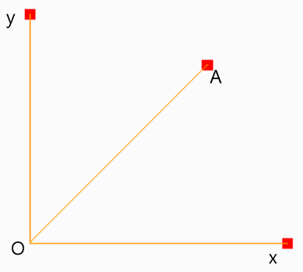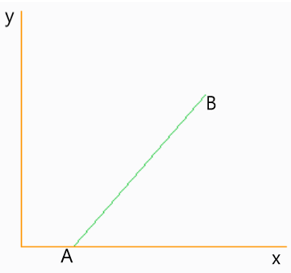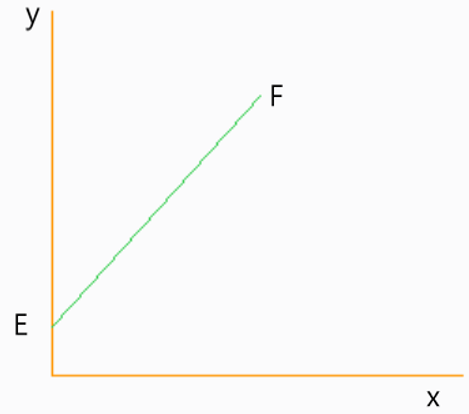1. In the given figure x axis is the radius of rotation and y axis is the controlling force, identify the correct option.
a) Curve represents isochronous governor
b) Curve represents stable governor
c) Curve represents unstable governor
d) Curve represents sensetive governor
Explanation: In the given figure, the straight line is passing through the origin thus following a relation
Fc = ar. Since there are no constants it represents an isochronous governor.
2. In the given figure x axis is the radius of rotation and y axis is the controlling force, identify the correct option. (For a spring controlled governor)
a) Curve represents isochronous governor
b) Curve represents stable governor
c) Curve represents unstable governor
d) Curve represents sensetive governor
Explanation: In the given figure, the straight line is below the axis representing the controlling force thus following a relation
Fc = ar – b. Since there is a negative constant it represents a stable governor.
3. In the given figure x axis is the radius of rotation and y axis is the controlling force, identify the correct option. (For a spring controlled governor)
a) Curve represents isochronous governor
b) Curve represents stable governor
c) Curve represents unstable governor
d) Curve represents sensetive governor
Explanation: In the given figure, the straight line is above the axis representing the controlling force thus following a relation
Fc = ar + b. Since there is a negative constant it represents an unstable governor.
4. It is possible that the equilibrium speed of the governor decreases with an increase of the radius of rotation of balls.
a) True
b) False
Explanation: If the equilibrium speed of the governor decreases with an increase of the radius of rotation of balls then Fc/r decreases as r increases. This is impracticable.
5. When the speed of the governor decreases, which of the following effect does friction causes?
a) Prevents downward movement of sleeve
b) Prevents upward movement of sleeve
c) Prevents radial outward movement of balls
d) Increases downward movement of sleeve
Explanation: In actual conditions there is always friction acting at joints and operating mechanisms of the governor, because of this while slowing down friction prevents the downward movement of sleeve
6. Because of friction acting at the joints, while speeding up it prevents the downward movement of sleeve.
a) True
b) False
Explanation: In actual conditions there is always friction acting at joints and operating mechanisms of the governor, because of this while speeding up friction prevents the upward movement of sleeve.
7. When the speed of the governor increases, which of the following effect does friction causes?
a) Prevents downward movement of sleeve
b) Prevents downward movement of sleeve
c) Prevents radial inward movement of balls
d) Increases upward movement of sleeve
Explanation: In actual conditions there is always friction acting at joints and operating mechanisms of the governor, as a consequence when the speed of rotation increases
8. For a porter governor, the following data is given:
Mass of each ball = 3kg
Mass on the sleeve = 15Kg
Length of each arm = 20cm
Ball path at life = 12 cm
Path at maximum speed = 16 cm
Calculate range of speed.
a) 14.15 rpm
b) 28.3 rpm
c) 56.9 rpm
d) 32.4 rpm
Explanation: h1 = 0.16m
h2 = 0.12m
N12 = ((m+M)/m) x895/h1= (18÷3)x895/0.16 = 33563
N1 = 183.2 rpm
N22 = ((m+M)/m) x895/h2= (18÷3)x895/0.12 = 44750
N2 = 211.5 rpm
therefore range = 28.3 rpm.
9. For a porter governor, the following data is given:
Mass of each ball = 3kg
Mass on the sleeve = 15Kg
Length of each arm = 20cm
Ball path at life = 12 cm
Path at maximum speed = 16 cm, If there is a friction at the sleeve of 10 N, find the coefficient of insensitiveness.
a) 11.3%
b) 5.00%
c) 8.66%
d) 5.66%
Explanation: We know that coefficient of insensitiveness is given by
F/(m+M)g
= 10/(3 + 15)9.81 = 5.66%
10. For a porter governor, the following data is given:
Mass of each ball = 5kg
Mass on the sleeve = 20Kg
Length of each arm = 20cm
Ball path at life = 12 cm
Path at maximum speed = 16 cm
Calculate range of speed in rpm.
a) 25.9
b) 51.8
c) 12.9
d) 31.2
Explanation: h1 = 0.16m
h2 = 0.12m
N12 = ((m+M)/m) x895/h1= (25÷5)x895/0.16 = 27968
N1 = 167.2 rpm
N22 = ((m+M)/m) x895/h2= (25÷5)x895/0.12 = 37291
N2 = 193.1 rpm
therefore range = 25.9 rpm